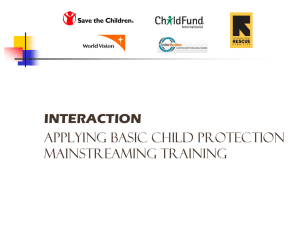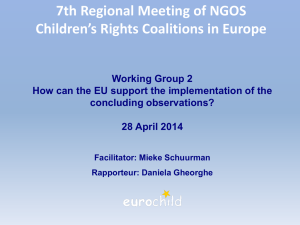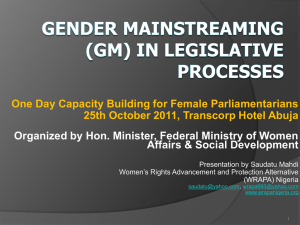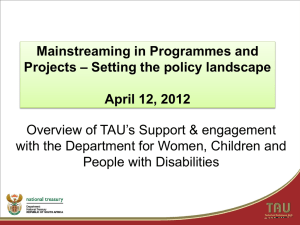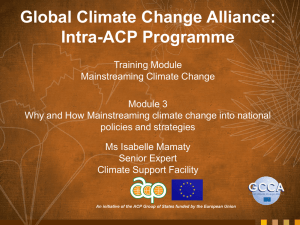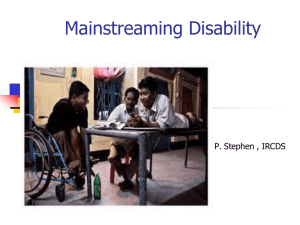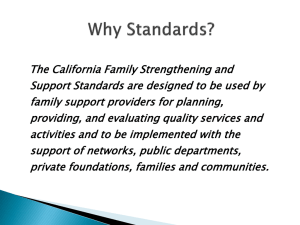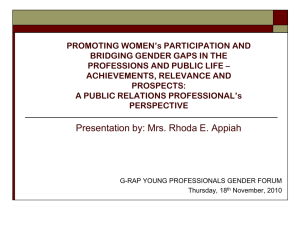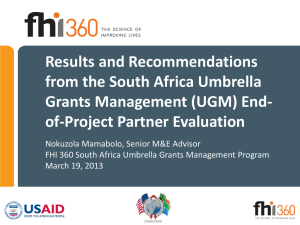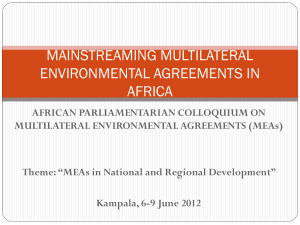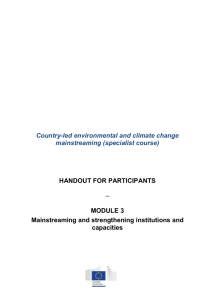Module 8 - Institutional Strengthening
advertisement
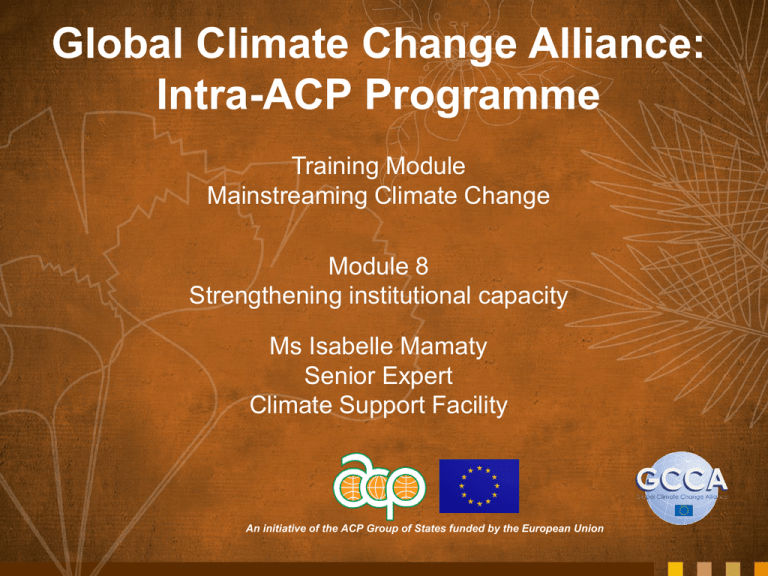
Global Climate Change Alliance: Intra-ACP Programme Training Module Mainstreaming Climate Change Module 8 Strengthening institutional capacity Ms Isabelle Mamaty Senior Expert Climate Support Facility An initiative of the ACP Group of States funded by the European Union Strengthening institutional capacity Learning objectives: o To understand that strengthening institutional capacity is at the core of mainstreaming climate change into development planning o To understand that mainstreaming climate change implies institutional changes to provide lasting results Expected outcomes: o Increased knowledge of the principles for institutional and capacity strengthening o Increased knowledge of the steps in institutional and capacity strengthening 2 Terminology Institutions o the rules, norms, structures and other social arrangements that shape and regulate human behaviour and interactions, and notably support decision making o institutions ≠ organisations o institutions can be formal or informal Institutional framework o a system made up of rules, laws, policies and institutions, in which various organisations interact with each other 3 Key institutional requirements for effective mainstreaming Cross-sectoral & cross-level coordination, cooperation Powerful champions at national level Effective mainstreaming Experience sharing, dissemination of good practices Timely stakeholder participation at various scales 4 e.g. office of prime minister, ministries of finance/budget/planning Integration of new thinking, new research in planning & monitoring systems & processes Strengthening of capacities of stakeholders at various scales Roles & responsibilities of main stakeholders Stakeholder group Main roles & responsibilities Central government (incl. office of Leadership, performance management frameworks Policies, standards & regulations Allocation of budget resources Guidance & capacity building prime minister, ministries of finance/budget/planning, ...) Local governments Implementation of national policies Integration with community strategies Private sector Preparation for losses & opportunities, risk mngt Contribution to sustainable investments & vulnerability reduction through development Scientific & academic organisations Policy-oriented research Support for decision making Investment promotion agencies Climate-proofing of investments, bridging of development gaps Poverty reduction organisations Climate change adequately addressed Adapted from: Schipper et al (2008) Principles for institutionalising climate change mainstreaming Source: UNDP-UNEP (2011) 6 Which institutional model? There is no single, ‘blueprint’ institutional model for effective mainstreaming of climate change Each country has to determine the most suitable institutional arrangements based on: o current institutional structures o a clear diagnosis of their strengths and weaknesses o a clear plan for overall governance improvement However, there are some agreed principles and examples of good practice 7 Principles for institutional and capacity strengthening (1) Move coordination of climate adaptation/mitigation to a central body with a coordination mandate and decision-making power over line ministries o e.g. China: National Development & Reform Commission o e.g. Kenya: Office of the President Establish or strengthen coordination mechanisms, with a clear allocation of responsibilities and permanent arrangements o e.g. Mexico: Inter-Ministerial Commission on Climate Change (CICC) with dedicated working groups 8 Source: UNDP-UNEP (2011) Principles for institutional and capacity strengthening (2) Build on pre-existing intersectoral coordination mechanisms wherever possible o e.g. coordination structures for food security, disaster risk reduction and management, sustainable land management, environmental management Institutionalise flexibility o e.g. commitment to regular policy/strategy revisions and reassessment of available knowledge Institutionalise adaptation/mitigation mainstreaming o e.g. in guidelines, procedures, systems, criteria for screening and prioritising programmes and projects 9 Source: UNDP-UNEP (2011) Principles for institutional and capacity strengthening (3) Develop effective national–local coordination mechanisms, identifying the most suitable level at which to cooperate/coordinate o e.g. Rwanda: annual performance contracts between various levels of government, with clear definition of goals, indicators and activities Strengthen institutions at the sub-national level, matching the transfer of competences with the transfer of resources 10 Source: UNDP-UNEP (2011) Tools and actions for supporting institutional and capacity strengthening 11 Steps in institutional and capacity strengthening Needs assessment National capacity selfassessment Working mechanisms Inst’l arrangements Management framework Work plan Learning by doing Training, exchange visits, on-the-job learning, lesson learning/dissemination Stakeholder analysis Mainstreaming as standard practice 12 Source: UNDP-UNEP (2009) Needs assessment: capacity development for whom, for what? Capacity development (CD) should take place at three complementary levels: o the ‘enabling environment’ or ‘system level’ (overall institutional level) o the organisation level Start by determining: o the individual level ‘Capacity development for what?’ -> Define specific objectives 13 Source: UNDP (2011) Needs assessment: stakeholders’ CD needs for mainstreaming Information systems & analytical skills Political & communication skills ‘Functional capacities’ Planning & prioritisation skills Stakeholder capacity building Participatory engagement & empowerment skills Specific technical skills Monitoring, evaluation & learning skills 14 ‘Technical capacities’ Source: Dalal-Clayton & Bass (2009) Needs assessment: national capacity self-assessments Based on existing or ad hoc institutional assessments, consider for all relevant organisations: o Level of education & awareness of climate change o Organisations’ mandates & functions with regard to climate-related issues o Influence of climate risks on capacity to function o Technical, financial, legal/regulatory capacities & information systems in relation to climate-related issues o Planning, decision-making, budget allocation & programming mechanisms o Collaboration & coordination structures & mechanisms 15 Source: UNDP-UNEP (2011) Setting up working mechanisms for a mainstreaming initiative Define institutional arrangements (political and technical) (e.g. steering and technical committees) Set up a management framework o Leadership arrangements o Human resources o Financial arrangements o M&E arrangements Develop an operational work plan 16 Source: UNDP-UNEP (2011) Learning-by-doing: multiple approaches Formal training on mainstreaming and on specific technical aspects Exchange visits On-the-job learning through national mainstreaming programmes (e.g. GCCA-funded) including: o Interdisciplinary teams o Twinning between organisations o Technical assistance o Demonstration projects Lesson learning and dissemination 17 Source: UNDP-UNEP (2009) Turning words into action 18 Discussion Questions and answers Strengthening institutional capacity what are the institutional and capacity needs in your organisation in order to enable the mainstreaming of climate change in your sector or at your level ? 19 Presentation of case studies Presentation of case studies of institutional strengthening approaches 20 Learning process exercise: Working group Exercise: development of an institutional map of your country 21 Recap – Key messages Institutional and capacity strengthening (rooted in a good diagnosis of the strengths/weaknesses of existing structures and efforts to improve governance) is a key condition for successful climate change mainstreaming Needs assessment, the setting up of effective working mechanisms and ‘learning by doing’ can support the mainstreaming process 22 Key references UNDP (2011) Practitioner’s Guide: Capacity Development for Environmental Sustainability. United Nations Development Programme, New York UNDP-UNEP (2011) Mainstreaming Adaptation to Climate Change into Development Planning: A Guide for Practitioners. UNDP-UNEP Poverty-Environment Initiative UNDP – Integrating environment into development: http://www.undp.org/mainstreaming/ 23 • Thank you • Contact: Dr. Pendo MARO, ACP Secretariat pendomaro@acp.int or +32 495 281 494 www.gcca.eu/intra-acp 24
